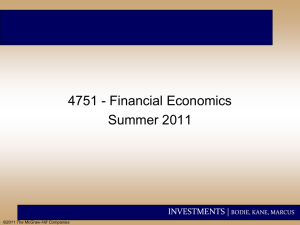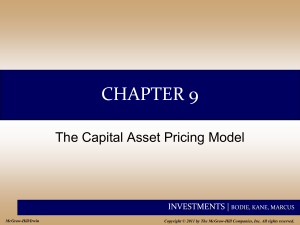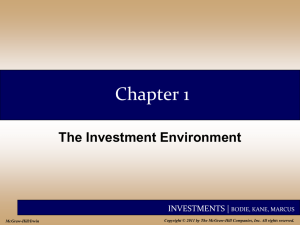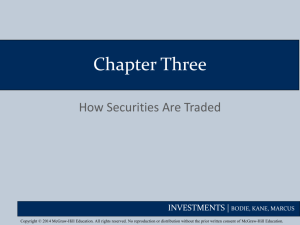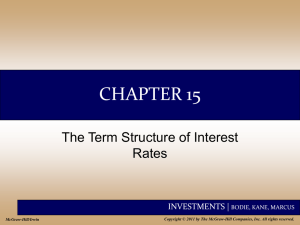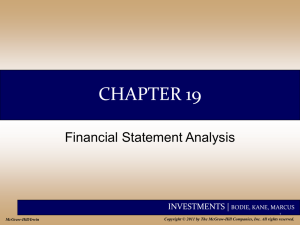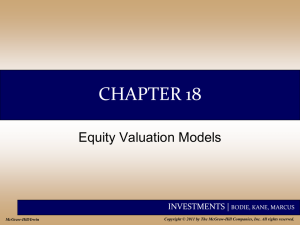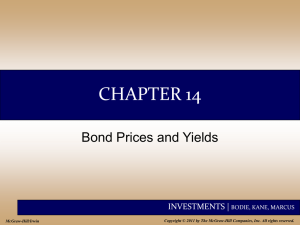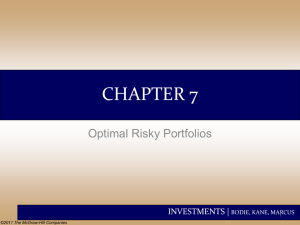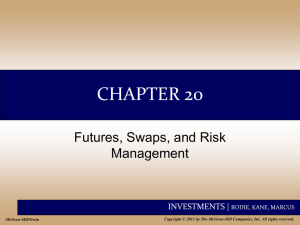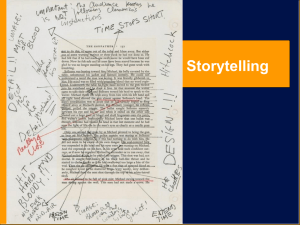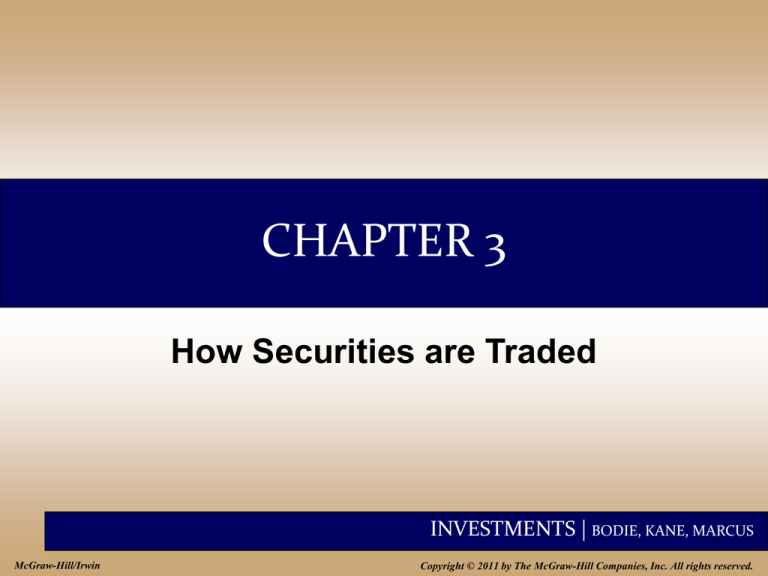
CHAPTER 3
How Securities are Traded
INVESTMENTS | BODIE, KANE, MARCUS
McGraw-Hill/Irwin
Copyright © 2011 by The McGraw-Hill Companies, Inc. All rights reserved.
3-2
How Firms Issue Securities
• Primary Market
– Firms issue new securities through
underwriter to public
– Investors get new securities; firm gets
funding
• Secondary Market
– Investors trade previously issued
securities among themselves
INVESTMENTS | BODIE, KANE, MARCUS
3-3
How Firms Issue Securities (Ctd.)
• Stocks
– IPO
– Seasoned offering
• Bonds
– Public offering
– Private placement
INVESTMENTS | BODIE, KANE, MARCUS
3-4
Investment Banking
• Underwriting: Investment bank helps the
firm to issue and market new securities
• Prospectus: Describes the issue and the
prospects of the company.
– Red herring
INVESTMENTS | BODIE, KANE, MARCUS
3-5
Figure 3.1 Relationship Among a Firm Issuing
Securities, the Underwriters, and the Public
INVESTMENTS | BODIE, KANE, MARCUS
3-6
Investment Banking
• Firm commitment
– investment bank purchases securities
from the issuing company and then
resells them to the public.
• Shelf Registration
– SEC Rule 415: Allows firms to register
securities and gradually sell them to the
public for two years
INVESTMENTS | BODIE, KANE, MARCUS
3-7
Investment Banking (Ctd.)
• Private placements
– Firm uses underwriter to sell securities
to a small group of institutional or
wealthy investors.
– Cheaper than public offerings
– Private placements not traded in
secondary markets
INVESTMENTS | BODIE, KANE, MARCUS
3-8
Initial Public Offerings
• Process
– Road shows to publicize new offering
– Bookbuilding to determine demand for
the new issue
– Degree of investor interest in the new
offering provides valuable pricing
information
INVESTMENTS | BODIE, KANE, MARCUS
3-9
Figure 3.3 Long-term Relative Performance of
Initial Public Offerings
INVESTMENTS | BODIE, KANE, MARCUS
3-10
How Securities are Traded
Types of Markets:
• Direct search
– Buyers and sellers seek each other
• Brokered markets
– Brokers search out buyers and sellers
INVESTMENTS | BODIE, KANE, MARCUS
3-11
How Securities are Traded
Types of Markets:
• Dealer markets
– Dealers have inventories of assets from
which they buy and sell
• Auction markets
– traders converge at one place to trade
INVESTMENTS | BODIE, KANE, MARCUS
3-12
Bid and Asked Prices
Bid Price
Ask Price
• Bids are offers to buy.
• In dealer markets, the
bid price is the price at
which the dealer is
willing to buy.
• Investors “sell to the
bid”.
• Bid-Asked spread is the
profit for making a
market in a security.
• Asked prices represent
offers to sell.
• In dealer markets, the
asked price is the price
at which the dealer is
willing to sell.
• Investors must pay the
asked price to buy the
security.
INVESTMENTS | BODIE, KANE, MARCUS
3-13
Types of Orders
• Market Order: Executed immediately
– Trader receives current market price
• Price-contingent Order:
– Traders specify buying or selling
price
• A large order may be filled at multiple
prices
INVESTMENTS | BODIE, KANE, MARCUS
3-14
Figure 3.5 Price-Contingent Orders
INVESTMENTS | BODIE, KANE, MARCUS
3-15
Trading Mechanisms
• Dealer markets
• Electronic communication networks
(ECNs)
– True trading systems that can
automatically execute orders
• Specialists markets
– maintain a “fair and orderly market”
INVESTMENTS | BODIE, KANE, MARCUS
3-16
NASDAQ
• Lists about 3,200 firms
• Originally, NASDAQ was primarily a dealer
market with a price quotation system
• Today, NASDAQ’s Market Center offers a
sophisticated electronic trading platform with
automatic trade execution.
• Large orders may still be negotiated through
brokers and dealers
INVESTMENTS | BODIE, KANE, MARCUS
3-17
Table 3.1 Partial Requirements for Listing
on NASDAQ Markets
INVESTMENTS | BODIE, KANE, MARCUS
3-18
New York Stock Exchange
• Lists about 2,800 firms
• Automatic electronic trading runs sideby-side with traditional
broker/specialist system
– SuperDot : electronic order-routing
system
– DirectPlus: fully automated execution for
small orders
– Specialists: Handle large orders and
maintain orderly trading
INVESTMENTS | BODIE, KANE, MARCUS
3-19
Table 3.2 Some Initial Listing
Requirements for the NYSE
INVESTMENTS | BODIE, KANE, MARCUS
3-20
Electronic Communication Networks
• ECNs: Private computer networks that
directly link buyers with sellers for
automated order execution
• Major ECNs include NASDAQ’s Market
Center, ArcaEx, Direct Edge, BATS, and
LavaFlow.
• “Flash Trading”: Computer programs look for
even the smallest mispricing opportunity and
execute trades in tiny fractions of a second.
INVESTMENTS | BODIE, KANE, MARCUS
3-21
Bond Trading
• Most bond trading takes place in the OTC
market among bond dealers.
• Market for many bond issues is “thin”.
• NYSE is expanding its bond-trading
system.
– NYSE Bonds is the largest centralized bond
market of any U.S. exchange
INVESTMENTS | BODIE, KANE, MARCUS
3-22
Market Structure in Other Countries
• London - predominately electronic
trading
• Euronext – market formed by
combination of the Paris, Amsterdam
and Brussels exchanges, then merged
with NYSE
• Tokyo Stock Exchange
INVESTMENTS | BODIE, KANE, MARCUS
3-23
Globalization and Consolidation of
Stock Markets
• NYSE mergers and acquisitions:
– Archipelago (ECN)
– American Stock Exchange
– Euronext
• NASDAQ mergers and acquisitions:
– Instinet/INET (ECN)
– Boston Stock Exchange
INVESTMENTS | BODIE, KANE, MARCUS
3-24
Globalization and Consolidation of Stock
Markets
• Chicago Mercantile Exchange
acquired:
–Chicago Board of Trade
–New York Mercantile Exchange
INVESTMENTS | BODIE, KANE, MARCUS
3-25
Figure 3.6 Market Capitalization of Major
World Stock Exchanges, 2007
INVESTMENTS | BODIE, KANE, MARCUS
3-26
Trading Costs
1. Brokerage Commission: fee paid to broker
for making the transaction
– Explicit cost of trading
– Full Service vs. Discount brokerage
2. Spread: Difference between the bid and
asked prices
– Implicit cost of trading
INVESTMENTS | BODIE, KANE, MARCUS
3-27
Buying on Margin
• Borrowing part of the total purchase
price of a position using a loan from a
broker.
• Investor contributes the remaining
portion.
• Margin refers to the percentage or
amount contributed by the investor.
• You profit when the stock appreciates.
INVESTMENTS | BODIE, KANE, MARCUS
3-28
Buying on Margin (Ctd.)
• Initial margin is set by the Fed
– Currently 50%
• Maintenance margin
– Minimum equity that must be kept in the
margin account
– Margin call if value of securities falls too much
INVESTMENTS | BODIE, KANE, MARCUS
3-29
Margin Trading:
Initial Conditions Example 3.1
Share price
$100
60%
Initial Margin
40%
Maintenance Margin
100
Shares Purchased
Initial Position
Stock $10,000 Borrowed
Equity
$4,000
$6,000
INVESTMENTS | BODIE, KANE, MARCUS
3-30
Maintenance Margin Example 3.1
Stock price falls to $70 per share
New Position
Stock $7,000 Borrowed $4,000
Equity
$3,000
Margin% = $3,000/$7,000 = 43%
INVESTMENTS | BODIE, KANE, MARCUS
3-31
Margin Call Example 3.2
How far can the stock price fall before a
margin call? Let maintenance margin = 30%
Equity = 100P - $4000
Percentage margin = (100P - $4,000) / 100P
(100P - $4,000) / 100P = 0.30
Solve to find:
P = $57.14
INVESTMENTS | BODIE, KANE, MARCUS
3-32
Table 3.4 Illustration of Buying Stock
on Margin
INVESTMENTS | BODIE, KANE, MARCUS
3-33
Short Sales
• Purpose: to profit from a decline in the
price of a stock or security
• Mechanics
– Borrow stock through a dealer
– Sell it and deposit proceeds and
margin in an account
– Closing out the position: buy the stock
and return to the party from which it
was borrowed
INVESTMENTS | BODIE, KANE, MARCUS
3-34
Short Sale:
Initial Conditions Example 3.3
Dot Bomb
50%
30%
$100
1000 Shares
Initial Margin
Maintenance Margin
Initial Price
Sale Proceeds
$100,000
Margin & Equity $50,000
Stock Owed
1000 shares
INVESTMENTS | BODIE, KANE, MARCUS
3-35
Example 3.3 (Ctd.)
Dot Bomb falls to $70 per share
Assets
$100,000 (sale proceeds)
$50,000 (initial margin)
Liabilities
$70,000 (buy shares)
Equity
$80,000
Profit = ending equity – beginning equity
= $80,000 - $50,000 = $30,000
= decline in share price x number of shares sold short
INVESTMENTS | BODIE, KANE, MARCUS
3-36
Short Sale - Margin Call
How much can the stock price rise before a
margin call?
($150,000* - 1000P) / (1000P) = 30%
P = $115.38
* Initial margin plus sale proceeds
INVESTMENTS | BODIE, KANE, MARCUS
3-37
Regulation of Securities Markets
• Major regulations:
– Securities Act of 1933
– Securities Act of 1934
– Securities Investor Protection Act of 1970
• Self-Regulation
– Financial Industry Regulatory Authority
– CFA Institute standards of professional
conduct
INVESTMENTS | BODIE, KANE, MARCUS
3-38
Regulation of Securities Markets
(Ctd.)
• Sarbanes-Oxley Act
– Public Company Accounting Oversight
Board
– Independent financial experts to serve
on audit committees of boards of
directors
– CEOs and CFOs personally certify firms’
financial reports
– Boards must have independent directors
INVESTMENTS | BODIE, KANE, MARCUS
3-39
Insider Trading
• Officers, directors, major stockholders
must report all transactions in firm’s stock
• Insiders do exploit their knowledge
– Jaffe study:
– Inside buyers>inside sellers = stock does
well
– Inside sellers>inside buyers = stock does
poorly
INVESTMENTS | BODIE, KANE, MARCUS

